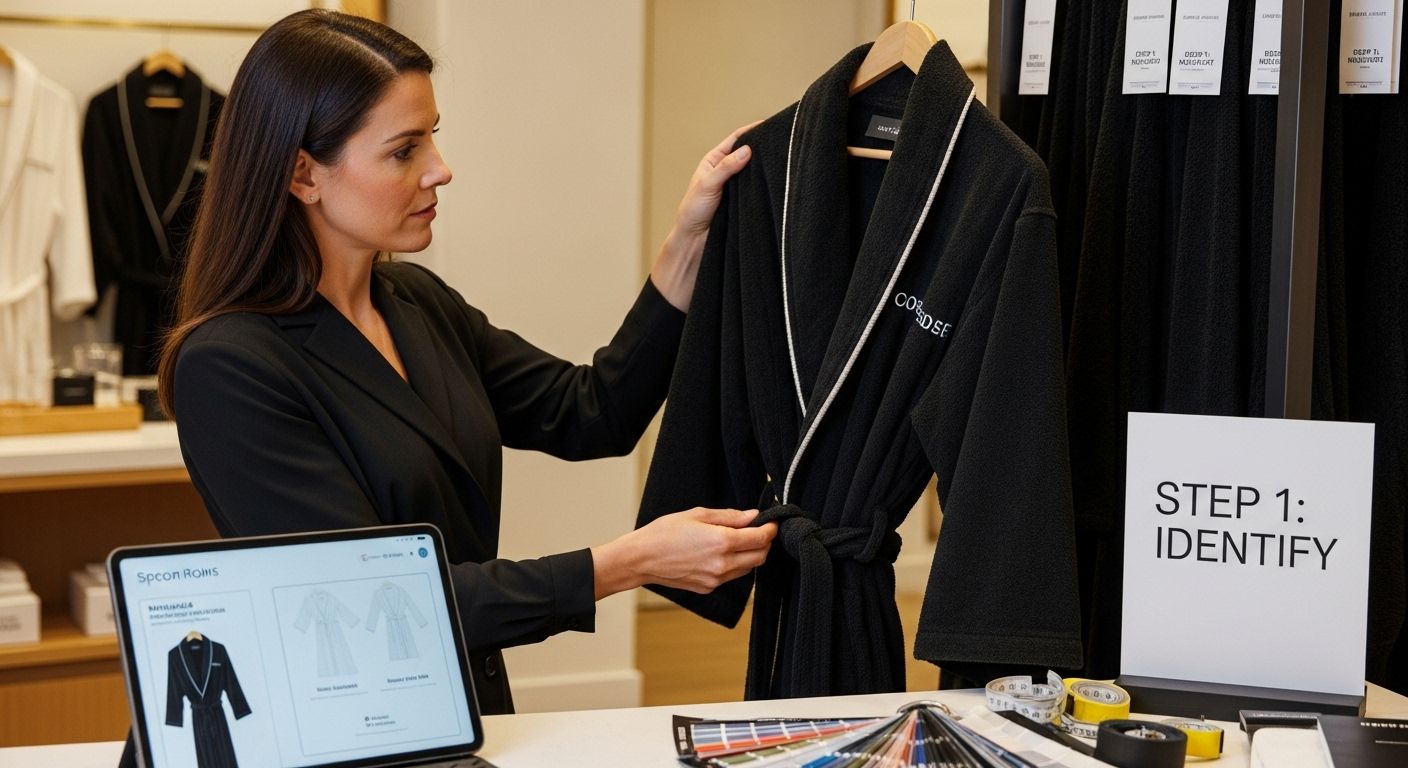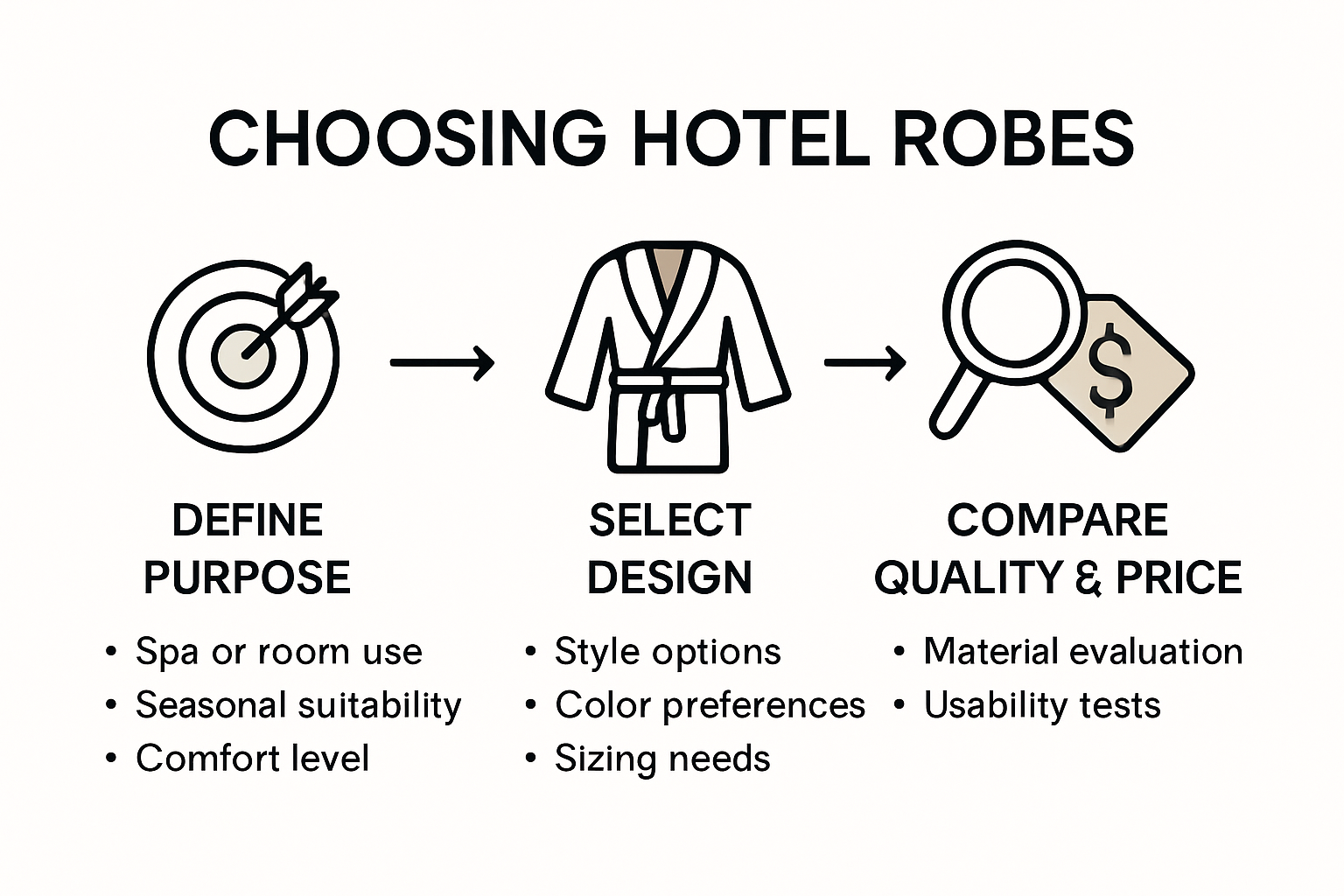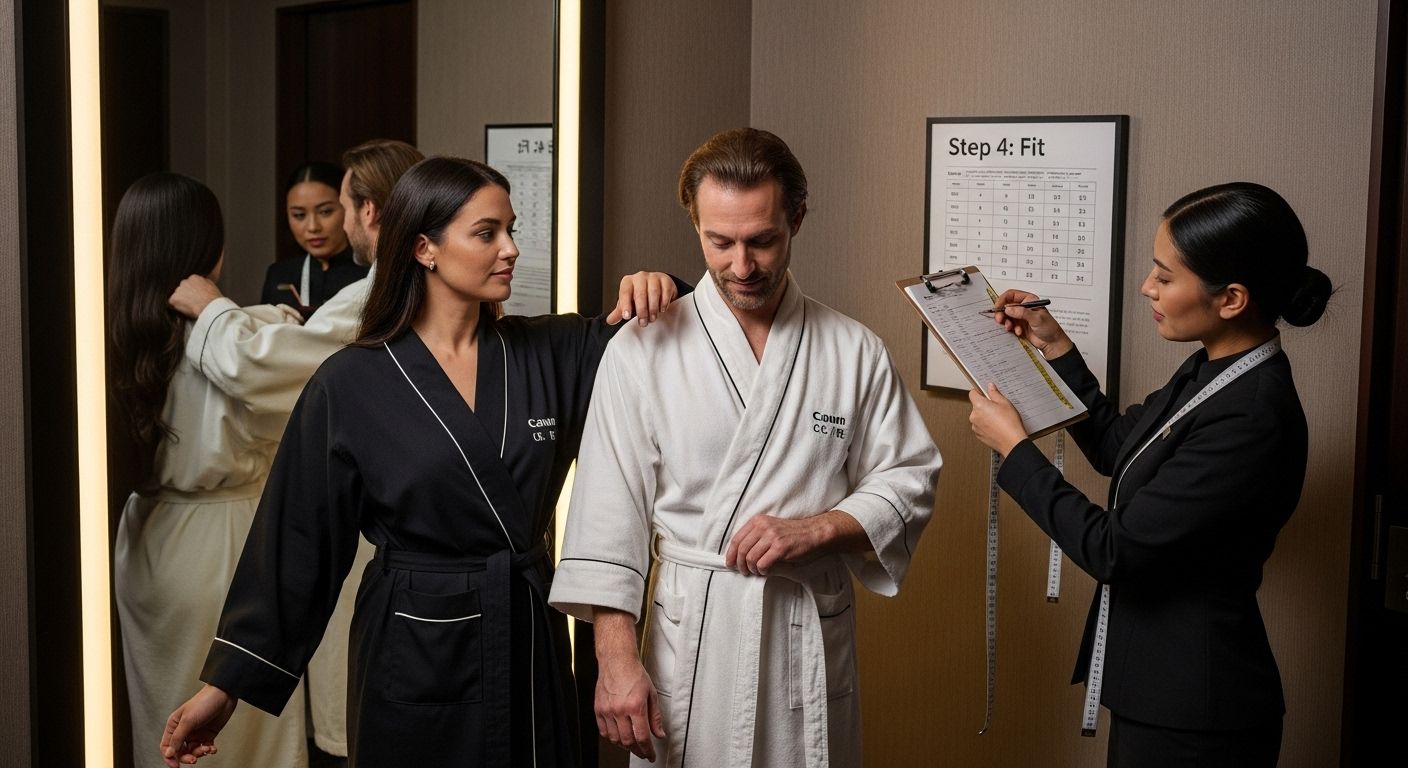Choosing the right hotel robe sounds simple, but it is filled with hidden details that impact everything from guest satisfaction to brand reputation. Imagine this. Research from the International Luxury Hotel Association shows that robes are not just basic amenities but critical brand touchpoints in hospitality spaces. Yet most buyers overlook the fact that every tiny decision – fabric, fit, even color – can turn an ordinary robe into a powerful statement of comfort and quality. Get ready to rethink everything you thought you knew about picking the perfect robe.

Table of Contents
- Step 1: Identify Your Purpose For The Robes
- Step 2: Research Material Options For Comfort And Durability
- Step 3: Consider Design And Aesthetic Preferences
- Step 4: Evaluate Sizing And Fit For Your Audience
- Step 5: Compare Price Points And Quality
- Step 6: Test Comfort And Usability Before Finalizing Your Choice
Quick Summary
| Key Point | Explanation |
|---|---|
| 1. Define the robe’s purpose carefully | Understanding the specific context informs all decisions about material, style, and durability to match your needs. |
| 2. Research materials for quality and comfort | Select fabrics based on their absorbency, breathability, and maintenance; the right material boosts user experience significantly. |
| 3. Prioritize design and aesthetic appeal | Choose colors, textures, and details that align with brand identity and enhance guest satisfaction through intentional design. |
| 4. Ensure proper sizing and fit | Develop a diverse sizing approach that accommodates various body types, enhancing comfort and usability for all users. |
| 5. Conduct thorough comfort tests | Testing robes in real-world scenarios gathers valuable feedback on usability, fit, and moisture management to ensure satisfaction. |

Step 1: Identify Your Purpose for the Robes
Choosing hotel robes is more than a simple purchase. It’s about understanding the specific context and function these luxurious garments will serve in your space. Different environments demand different robe characteristics, whether you’re outfitting a high-end spa, creating a welcoming guest experience in a boutique hotel, or designing a personal relaxation sanctuary at home.
The purpose of your robes fundamentally shapes every subsequent decision in the selection process. Are you seeking robes for guest comfort in a hospitality setting? For spa and wellness center use? For personal home luxury? Each scenario requires a nuanced approach to material, weight, style, and durability.
In a professional hospitality context, research from the International Luxury Hotel Association demonstrates that robes are not merely functional items but critical brand touchpoints. They communicate your establishment’s commitment to guest comfort and attention to detail. A plush, well-chosen robe can transform a standard room experience into a memorable, luxurious moment.
For personal use, the purpose becomes more intimate. Home robes might prioritize different qualities like softness, warmth, or quick-drying capabilities depending on your lifestyle. A busy parent might prefer a durable, machine-washable terry cloth robe, while someone seeking ultimate relaxation might invest in a sumptuous silk or microfiber option.
Key considerations when identifying your robe’s purpose include:
- Frequency of use
- Specific environment (humid spa, dry hotel room, home bathroom)
- Target user demographic
- Maintenance requirements
- Budget constraints
By meticulously defining your robes’ purpose upfront, you create a clear roadmap for making informed selections that align perfectly with your specific needs. The right robe is more than fabric. It’s an experience, a statement of comfort, and a reflection of your commitment to quality.
Step 2: Research Material Options for Comfort and Durability
Researching robe materials is a critical step in selecting the perfect garment that balances luxury, practicality, and longevity. Different fabrics offer unique characteristics that dramatically impact user experience, making material selection far more nuanced than a simple aesthetic choice.
Natural fibers like cotton and linen have long been staples in robe manufacturing. Cotton terry robes provide exceptional absorbency and softness, making them ideal for post-shower or spa environments. Linen offers remarkable breathability and becomes softer with each wash, creating a lightweight option perfect for warmer climates.
Research from the Textile Institute reveals that synthetic materials like microfiber and polyester are gaining significant popularity due to their remarkable durability and easy maintenance. Microfiber robes, in particular, represent a technological breakthrough in textile engineering. These robes are incredibly lightweight, quick-drying, and resistant to wrinkles, making them an excellent choice for high-traffic hospitality environments.
When evaluating materials, consider performance metrics beyond basic comfort. Factors like moisture-wicking capabilities, shrinkage resistance, color retention, and ease of cleaning become paramount. Silk robes offer unparalleled softness but require delicate handling, while waffle-weave robes provide excellent thermal regulation and a textured aesthetic that many guests find appealing.
Budget considerations also play a crucial role in material selection. While luxurious options like Egyptian cotton or silk represent premium choices, blended materials can provide an excellent compromise between cost and quality. Polyester-cotton blends, for instance, offer improved durability and lower maintenance requirements compared to pure natural fibers.
Key material evaluation criteria include:
- Fabric weight and thickness
- Moisture absorption properties
- Maintenance requirements
- Potential for color fading
- Cost per unit
By methodically examining these factors, you’ll develop a comprehensive understanding of material options that align perfectly with your specific robe requirements. Remember that the ideal material is not just about immediate comfort but also long-term performance and value.
To help you evaluate and compare commonly used robe materials based on attributes already discussed, the table below provides a quick-reference summary of each option’s comfort, durability, and maintenance factors.
| Material | Comfort Qualities | Durability | Maintenance Needs |
|---|---|---|---|
| Cotton Terry | Soft, absorbent | Moderate | Easy, machine washable |
| Linen | Lightweight, breathable | High | Becomes softer with wash |
| Microfiber | Light, quick-drying | Very high | Easy, low maintenance |
| Polyester | Smooth, less absorbent | High | Very easy |
| Silk | Luxurious, ultra soft | Low | Delicate care required |
| Waffle Weave (Cotton) | Textured, thermo regulating | Moderate | Easy, machine washable |
| Polyester/Cotton Blend | Balance of softness and strength | High | Low, resists shrinkage |
Step 3: Consider Design and Aesthetic Preferences
Design and aesthetic preferences transform robes from mere functional garments into powerful expressions of style and brand identity. The visual and tactile experience of a robe goes far beyond its basic utility, communicating sophistication, comfort, and attention to detail through carefully selected design elements.
Color plays a profound psychological role in robe selection. Neutral tones like white, cream, and soft gray convey elegance and cleanliness, making them perennial favorites in hospitality settings. Deeper hues such as navy, burgundy, or forest green can add a sense of luxury and depth, creating a more dramatic visual statement that resonates with guests seeking a premium experience.
Research from the Journal of Hospitality and Tourism underscores how aesthetic elements significantly contribute to guest satisfaction. The design of your robes should harmonize with your broader interior design strategy, creating a cohesive and immersive environment that feels intentional and refined.
Texture introduces another critical dimension to robe aesthetics. Waffle weave patterns offer a classic, sophisticated look with excellent visual depth, while smooth microfiber presents a sleek, modern appearance. Quilted or embroidered details can elevate a simple robe into a statement piece, adding visual interest and perceived value.
Consider your target audience when making aesthetic choices. A boutique hotel catering to young professionals might opt for minimalist, contemporary designs with clean lines. A wellness retreat could choose earthy, organic tones and softer, more flowing silhouettes that evoke tranquility and natural harmony.
Key aesthetic considerations include:
- Color palette alignment with brand identity
- Texture and visual complexity
- Trim and finishing details
- Potential for personalization or monogramming
- Overall visual harmony with surrounding environments
Remember that aesthetic preferences are deeply personal. What looks stunning in one context might feel out of place in another. The goal is to create a robe design that feels simultaneously universal in its appeal and specific to your unique setting. Trust your instincts, but also seek feedback from potential users to ensure your aesthetic choices resonate authentically.
Step 4: Evaluate Sizing and Fit for Your Audience
Sizing and fit represent the critical intersection between comfort, functionality, and user satisfaction when choosing hotel robes. The perfect robe is not just about measurements, but about understanding the diverse body types and preferences of your specific audience.
Universal sizing requires a nuanced approach that goes beyond traditional small, medium, and large categories. Different hospitality environments demand unique sizing strategies. A luxury spa might prioritize robes with more generous cuts that accommodate movement and relaxation, while a boutique hotel could require more tailored, streamlined designs that create a sleek silhouette.
Research from the National Institute of Standards and Technology highlights the importance of using current anthropometric data to develop accurate sizing systems. This means moving beyond one-size-fits-all solutions and creating a more inclusive approach that respects body diversity.
Consider developing a comprehensive sizing matrix that includes multiple dimensions. Sleeve length, shoulder width, chest measurements, and overall robe length become crucial factors. For hotels and spas serving international guests, understanding global body type variations becomes essential. Some regions have distinct body shape characteristics that require specialized sizing approaches.
Material selection from previous steps directly impacts fit. Stretchy microfiber fabrics offer more forgiving sizing options, while stiffer materials like heavy cotton require more precise measurements. A robe that looks magnificent on a hanger but restricts movement fails its primary purpose of providing comfort and relaxation.
Key sizing evaluation criteria include:
- Range of size options available
- Flexibility of fabric
- Adjustability features like belts or ties
- Potential for custom sizing
- Comfort across different body types
Practical fit testing is non-negotiable. Request sample robes in multiple sizes, have staff or test subjects try them on, and gather detailed feedback. Pay attention to how robes drape, where they fall on the body, and how easily they can be fastened. The goal is creating a garment that feels like a second skin – comfortable, unrestricting, and effortlessly elegant.

Step 5: Compare Price Points and Quality
Comparing price points and quality transforms the robe selection process from a simple purchase to a strategic investment. Price is not merely a number but a complex reflection of material quality, craftsmanship, durability, and brand reputation. Navigating this landscape requires a nuanced approach that balances immediate cost considerations with long-term value.
Initial price comparisons might tempt you toward the lowest-cost option, but experienced hospitality professionals understand that cheap robes can become expensive mistakes. A robe that deteriorates quickly, loses its softness after few washes, or fails to provide guest comfort will ultimately cost more in replacement and reputation damage.
Research from Hospitality Net demonstrates that consumer reviews and perceived quality significantly influence purchasing decisions, often outweighing pure price considerations. This means investing in slightly higher-priced robes with superior construction can yield better guest satisfaction and potentially reduce long-term replacement costs.
Consider the total cost of ownership beyond the initial purchase price. Factors like fabric durability, ease of maintenance, colorfastness, and potential for customization contribute to a robe’s true economic value. A microfiber robe that withstands hundreds of industrial washings might cost more upfront but prove more economical over its lifecycle compared to a cheaper alternative that requires frequent replacement.
Quality assessment goes beyond price tags. Examine manufacturing details like seam construction, fabric weight, stitching consistency, and finishing touches. High-quality robes feature reinforced seams, precise hemlines, and attention to details that communicate sophistication and durability.
Key price and quality evaluation criteria include:
- Cost per use
- Durability and maintenance requirements
- Potential for customization
- Fabric performance characteristics
- Manufacturer warranty
Remember that the most expensive option is not always the best, nor is the cheapest the worst. Your goal is finding the sweet spot where price, quality, and your specific requirements intersect perfectly. Obtain samples, request detailed specifications, and don’t hesitate to negotiate volume discounts that can make higher-quality options more financially accessible.
Step 6: Test Comfort and Usability Before Finalizing Your Choice
Testing comfort and usability represents the critical final checkpoint in selecting the perfect hotel robe. This step transforms theoretical selection into practical validation, ensuring that your carefully researched choices translate into real-world performance and guest satisfaction.
Comfort testing goes far beyond simply trying on a robe for a few moments. It requires a comprehensive evaluation that simulates actual usage scenarios. Consider recruiting a diverse group of test subjects representing different body types, ages, and mobility levels to provide comprehensive feedback. Their experiences will reveal nuances that individual assessments might miss.
Research from the National Research Council emphasizes the critical importance of designing products that are safe, comfortable, and easy to use. In the context of hotel robes, this means examining factors beyond basic fit, such as range of motion, fabric breathability, weight distribution, and ease of fastening.
Simulate real-world scenarios during your testing process. Have participants wear robes after simulated shower experiences, while relaxing, and during light movement. Observe how robes drape, whether they restrict movement, and how comfortable they remain during different activities. Pay attention to subtle details like belt placement, sleeve length, and how easily the robe can be adjusted.
Moisture management becomes a crucial comfort factor. Test how quickly robes dry, their ability to wick away moisture, and how they feel against the skin when damp. A robe that becomes heavy or uncomfortable when slightly wet fails the fundamental test of guest comfort.
Key comfort and usability testing criteria include:
- Range of motion while wearing the robe
- Fabric breathability and moisture management
- Ease of putting on and taking off
- Comfort during different activities
- Perceived quality and softness
Document your findings meticulously. Collect both quantitative measurements and qualitative feedback. A robe that looks perfect on paper but fails in practical testing is not the right choice. Trust the empirical evidence gathered through thorough, multi-perspective testing to guide your final selection.
To make your robe shopping process easier, the following checklist table helps you verify all essential selection criteria covered in the guide. Check off each item as you proceed through your decision.
| Selection Step | Criteria to Check | Complete (✔/✗) |
|---|---|---|
| Identify Purpose | Purpose clearly defined | |
| Evaluate Material | Assess comfort, durability, maintenance | |
| Consider Design & Aesthetics | Color, texture, matches brand/environment | |
| Assess Sizing & Fit | Range tested, fit for target audience | |
| Compare Price & Quality | Balance cost vs. durability & reputation | |
| Test Comfort & Usability | Real-world, multi-user testing complete | |
| Gather Feedback Before Purchase | Collect and review user feedback |
Elevate Your Comfort With Lotus Linen Hotel Robes
Are you struggling to find hotel robes that truly balance comfort, style, and long-lasting quality? After reading this guide you already know the importance of choosing premium materials, thoughtful sizing, and designs that reflect your unique needs. At Lotus Linen, we help you solve that challenge with expertly crafted robes that deliver on every detail discussed in “Master Choosing Hotel Robes for Ultimate Comfort & Style.” Whether you seek plush absorbency for spa-like relaxation, lightweight waffle robes for everyday luxury, or want your brand embroidered on each piece, discover options made to exceed expectations at Lotus Linen.

Ready to create the perfect guest experience or upgrade your relaxation at home? Shop our full collection of customizable robes for every taste and experience premium comfort today. Do not wait. The right robe is just a click away at Lotus Linen.
Frequently Asked Questions
What materials are best for hotel robes?
Natural fibers like cotton and linen are popular due to their softness and absorbency, while synthetic materials like microfiber offer durability and quick-drying properties. Each material has unique advantages depending on the intended use of the robe.
How should I choose the right size and fit for hotel robes?
Consider developing a sizing matrix that includes multiple dimensions like sleeve length and overall robe length. It’s important to test fit across diverse body types to ensure comfort and functionality in various environments.
What design features should I look for in a hotel robe?
Key design features include color selection that aligns with your brand identity, texture for a sophisticated look, and details like embroidery or monogramming for personalization. The design should harmonize with the surrounding environment to enhance the overall aesthetic.
How can I evaluate the quality of hotel robes before purchasing?
Examine factors such as fabric weight, seam construction, and overall craftsmanship. Consider the total cost of ownership by assessing durability, maintenance needs, and potential for customization, rather than relying solely on price tags.
Recommended
-
[ Best Towels & Bathrobes
– Lotus Linen
](https://www.shoplotuslinen.com/blogs/news/ultimate-guide-on-how-to-choose-best-towels-and-bathrobes)
-
[ Top 10 Most Luxurious Bathrobes
– Lotus Linen
-
[ Why Use Bathrobes? Comfort, Style & Gift Trends for 2025
– Lotus Linen
](https://www.shoplotuslinen.com/blogs/news/why-use-bathrobes-comfort-luxury-gift-trends-2025)
-
[ Affordable Hotel Quality Robes
– Lotus Linen
](https://www.shoplotuslinen.com/blogs/news/best-hotel-quality-robes-affordable-durable)
